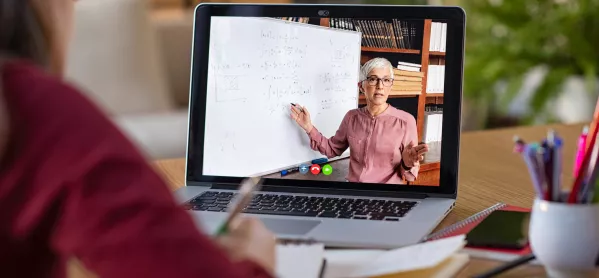- Home
- 3 reasons remote CPD should be the future
3 reasons remote CPD should be the future

In February of this year, I was one of four presenters at an evening CPD session.
It was “local” to where I live, but it still meant a round trip of more than two hours, during rush hour, in the dark of the depths of winter.
Usually, that journey would have been on top of my one-hour commute home from work: as it is, it was during my maternity leave so, although it required arranging childcare, I had no other work commitments, lesson-planning or marking to reorganise.
The presentations were high quality and made for an enjoyable and thought-provoking evening, but I left wondering how feasible it would have been to take part under normal circumstances.
Last night, I attended a CPD session in a very different setting. I travelled for around 45 seconds, settled down in an armchair and joined more than 300 other teachers from around the world on a Zoom call.
The training cost me £4.76, of which 50% is a charitable donation. Like the “real-life” CPD, Jenny Webb’s presentation was high quality and made for an enjoyable and thought-provoking evening.
I came away with resources, book recommendations and a range of practical ideas. Practically, it was a breeze. I was left wondering: is this the future of CPD?
There are three compelling reasons why, for me, the answer is “yes”.
1. Time
Reducing the travel time associated is an undeniable advantage and no small consideration: the most central of conferences can be prohibitively far for those who live on the coast, have family responsibilities or are simply drowning in workload.
2. Cost
As well as the travel costs to and from the venue, there are, in some cases, hotel bookings to be considered. And that’s before attendees or their employers have paid for the provision itself.
Online CPD reduces the overheads of venue and technology, enabling lower attendance fees: of the eight sessions I have booked, none have cost more than £7.
3. Convenience
Most of the platforms that are being used by trainers offer a record option and this has been used in all the sessions I’ve undertaken.
While watching a recording does remove the opportunity to engage in live conversation or ask immediate questions, it creates a flexibility that supports wellbeing by offering teachers more choice about when to schedule their own CPD.
For some, this might be during their own time, but, in the longer term, I see no reason why these sessions wouldn’t form part of Inset or other training within the school day.
Not only does this allow for a raft of subject-specific presentations, but it also presents schools with the chance to provide different pedagogical training according to whole-school, departmental or team-based priorities - perhaps even simultaneously.
A digital network
Of course, for some, attending a conference can feel like a bit of an adventure - a day out of school routine and, in some cases, a shorter commute than usual.
It is difficult to argue that online CPD offers the same warmth of connection and networking opportunities as face-to-face training, but sadly, the latter simply isn’t an option for the foreseeable future.
However, I’d argue that the network itself is potentially wider for online CPD because of the greater number and range of teachers able to attend: individuals are less constrained by personal or school budgets or circumstance and, for those using social media to made edu-connections, there is the opportunity to build on even the briefest of meetings.
We don’t know what will come of the unusual interactions and working practices we’re all managing during the pandemic and we can only hope for positives in our new normal, whenever that settles.
However, in a world and career where time is everything and cost seems set to be an even more pressing concern, online CPD offers an opportunity for teachers to develop skills, professional networks and confidence without such an assault on our time and budgets - it’s an opportunity we shouldn’t pass up.
Pippa McKeown is deputy head of English at The Grange School, Cheshire. She tweets @Ms_McK_says
Keep reading for just £1 per month
You've reached your limit of free articles this month. Subscribe for £1 per month for three months and get:
- Unlimited access to all Tes magazine content
- Exclusive subscriber-only stories
- Award-winning email newsletters
